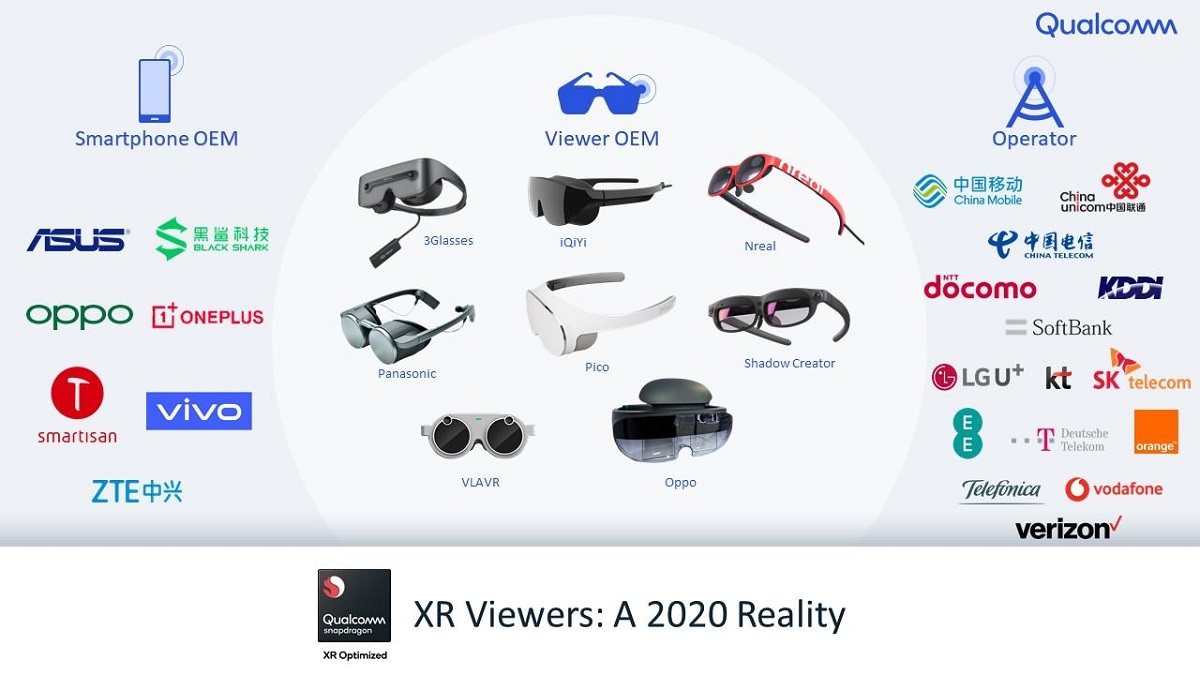
Qualcomm has introduced a new reference design for augmented reality glasses. The Qualcomm AR XR1 Smart Viewer offers Full HD resolution per eye, 90 Hz. refresh rate, multiple cameras for a virtual overlay, hand tracking, and several other features.
Qualcomm clearly wants Augmented Reality headsets to become a common and regularly used accessory. The Qualcomm Smart Viewer AR glasses can tether to a phone or PC via the standard USB Type-C port.
Qualcomm AR XR1 Smart Viewer “Reference Design” specifications:
Qualcomm is offering the AR XR1 Smart Viewer as a consumer-focused “must-have accessory” for phones and computers. In other words, the company’s reference design isn’t self-contained, wireless, or untethered Augmented Reality glasses.
The AR glasses have 0.71-inch microdisplays. These are 1920 x 1080 OLED displays with a 90Hz refresh rate. In other words, instead of the 2K resolution per eye which the Facebook Oculus Quest 2 standalone AR gaming glasses offer, the Qualcomm AR XR1 Smart Viewer offers Full HD resolution per eye.
Qualcomm Snapdragon XR1 AR Smart Viewer Reference Design released https://t.co/YqCwwhD41j via @Android Community
— Nestor Garcia (@maelmefis90) February 24, 2021
Qualcomm’s reference design has six degrees of motion-tracking, hand-tracking, and dual 1MP cameras. Interestingly, there’s even support for an 8MP RGB camera. Qualcomm claims these additional camera systems can deliver “See What I See” remote assistant functionality.
Qualcomm has designed the Smart Viewer glasses reference design to test both desktop and mobile applications. In other words, users can quickly and effortlessly tether the AR Smart Viewer to a smartphone, desktop PC, computing puck, or potentially even a 5G-connected device.
The Qualcomm Snapdragon XR1 #AR Smart Viewer Reference Design is Qualcomm Technologies’ first #augmented #reality (AR) reference design based on the Qualcomm Snapdragon XR1 Platform. Click https://t.co/k6UHX77JV4 #5G #5gnr #ran #core #ai #mimo #researchers #edge #cloud #iot pic.twitter.com/1iCACeUp4n
— 5gusecaseaccelerator (@5Gusecase) February 24, 2021
Incidentally, in addition to gaining from the better performance capabilities of the tethered PC or smartphone, the Smart Viewer has on-board processing. Together the entire AR system can distribute various workloads as needed.
It is important to note that Qualcomm is packing its own Snapdragon XR1 SoC. The company optimizes this platform for virtual and augmented reality glasses. Incidentally, Facebook’s Oculus Quest 2 VR headset packs the newer Snapdragon XR2 SoC.
Qualcomm is using the tweaked XR1 Smart Viewer system. The company has designed the platform to perform some tasks using built-in electronics. However, the glasses offload tasks that require heavy processing to an external computing device.
Qualcomm AR XR1 Smart Viewer “Reference Design” features:
The Qualcomm AR XR1 Smart Viewer AR glasses can detect planes in the environment. This opens up several functionalities.
Users can, for example, pin a virtual window to a wall for multiple PC displays. They can also place a virtual object on a table and interact with it through gesture controls.
qualcomm's AR 'smart viewer' lets you free your desk with virtual screens – Designboom https://t.co/2gj5E3CvFM pic.twitter.com/BNpPGgqIQD
— @globalfirstnews (@globalfirstnews) February 24, 2021
When connected to an Android phone, Qualcomm AR Smart Viewer can open apps in a 2D framework. This will allow users to see things in the display both privately and hands-free.
Meanwhile, users can wear the AR Smart Viewer indoors to render multiple virtual displays. These glasses also serve a more recreational purpose.
Qualcomm's Smart Viewer Arrives to Help Speed Up AR Development #AugmentedReality via https://t.co/8zHOhjQNSz https://t.co/mN2oSaySDm
— Reform Reality (@ReformReality) February 24, 2021
In other words, users can watch movies or other multimedia content on the Qualcomm AR XR1 Smart Viewer. At other times, people can even attend virtual AR meetings using the Smart Viewer.
Interestingly, the Lenovo ThinkReality A3 AR Smart Glasses have adopted the Qualcomm Smart Viewer platform.


